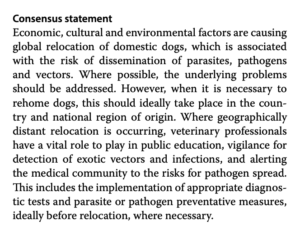
COVID-19: stay at home
On 11 March 2020, the World Health Organization (WHO) declared the novel coronavirus (COVID-19) outbreak a global pandemic. Countries around the world quickly implemented measures to slow the spread of the virus, such as national lockdowns, quarantines, curfews and school closures. Many people found themselves working from home, furloughed or unemployed, but certainly stuck at home. Now almost a year later, many people have found being home-based their “new normal”. While this may or may not have been a welcome change to work life, as social restrictions increased during the pandemic, so did the rate of dog adoptions.
Demand for dogs during the pandemic
The Dogs Trust, the largest dog welfare charity in the UK, recently reported that the demand for dogs has been at an all-time high during the pandemic, with enquiries rising by 62% from 2019 to 2020. Around the world, surges in demand saw rescue shelters emptied and centres struggling to meet the demands. Dogs are not only rehomed locally, but also often relocated over large geographical distances, as public desire to adopt dogs from abroad that have often had their welfare compromised is increasing. Further, the rise in demand for dogs has encouraged puppy farming and the illegal supply of puppies across different countries. The puppies may come with falsified veterinary documents, are often not vaccinated and could have health problems, often leading to them being given up or abandoned.
Parasites and vector-borne diseases disseminated by rehomed dogs
The recent consensus statement on parasites and vector-borne diseases disseminated by rehomed dogs is therefore a timely publication from the Companion Vector‐Borne Diseases (CVBD) World Forum. The CVBD World Forum is a working group of leading international experts who meet annually to evaluate current scientific findings and future trends concerning the distribution, pathogenesis, clinical presentation, diagnosis and prevention of vector‐borne infections of dogs and cats. At the 14th Symposium of the CVBD World Forum in Trieste, Italy (March 25–28, 2019), the group highlighted that continuous relocation of dogs both within and between countries represents a global veterinary and public health concern. A concern that will have undoubtedly intensified since the symposium took place in early 2019.

The consensus statement aimed to clarify the role of the veterinary profession regarding relocation of dogs, international rehoming advice, surveillance, and control of parasites and pathogens for imported and exported dogs. Geographically distant rehoming of dogs can spread a number of zoonotic parasitic, viral and bacterial infections, such as Leishmania spp. (Svobodova 2017, McKenna 2019), rabies (Klevar 2015), Brucella spp. (Brower 2007) or Leptospira spp. (Miotto 2018). Spread of drug-resistant pathogens is also a growing concern, such as drug-resistant heartworm and hookworm in North America.
The role of veterinary professionals in preventing disease spread
The working group report that veterinary professionals have an important role to play in maintaining biosecurity, reducing zoonotic risk to pet owners and the wider public, and improving the health of stray dogs. Responsibilities of veterinary professionals therefore include:
(i) educating the public about the risks of adopting dogs from abroad or distant regions within a country and informing them about the benefits of adopting dogs locally. Most charities working in this field and people adopting pets do so with the best of intentions but they may be unaware of the risks.
(ii) asking about travel history for any recently acquired pet and advising appropriate diagnostic testing and preventative treatments depending on parasites and other pathogens present in the country of origin and relevant clinical signs.
(iii) vigilance in looking for exotic ticks or other arthropods on imported dogs and clinical signs that may indicate infection with pathogens not known to be locally endemic in the region of origin;
(iv) reporting all findings of unusual ticks or arthropods and unusual infections to local health authorities, universities, independent organisations such as those mentioned in point (ii) and through peer-reviewed publications. Publications can facilitate an up-to-date picture of where vectors and pathogens may be emerging, such as Haemaphysalis longicornis ticks in North America (Beard 2018), Rhipicephalus sanguineus ticks in northern European households (Hansford 2015), Babesia canis in the UK (Swainsbury 2016, Phipps 2016), heartworm (Dirofilaria immitis) in Colorado (Drake 2019), Ehrlichia canis in Australia (Government of Western Australia 2020) and Leishmania spp. transmission to untraveled dogs in the absence of sand fly vectors in the Czech Republic (Svobodova 2017) and in the UK (Wright 2019, McKenna 2019).
Conclusions
The recent consensus statement from the Companion Vector‐Borne Diseases (CVBD) World Forum highlighted the zoonotic implications of rehoming dogs, particularly across wider geographic areas. The publication outlined the important role veterinary professionals have to play in surveillance and control of parasites and pathogens from imported and exported dogs. As the pandemic continues to keep many people at home, demand for dogs will likely continue to rise, and local dogs may be scarce. Rehoming dogs and purchasing puppies from abroad is done with the best intentions by well-meaning animal lovers, but the public must be aware of the potential risks of spreading zoonoses. With that, I leave you with a picture of my beloved rescue dog, Ralph.


Comments